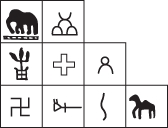Cast Copper Coins
Cast Copper Coins are among the most important early Bengal coins and next to punch marked coins in numismatic importance. These coins were used widely in the markets of Bengal during Maurya-Sunga periods but were in use even in the Gupta age. These coins bear only some symbols but do not have any legends inscribed on them.

The most important aspect of cast copper coins is that they do not contain any signs of any king or dynasty. Thus their designs hardly indicated any change. The symbols used in them indicate the traditional folk-arts prevailing in Bengal. The conservatism of agrarian Bengal is reflected in the symbols.
The craftsmen of Bengal continued to create objects of the same type from generation to generation. This helped them to achieve perfection in the design and allowed them to maintain uniformity in weight. These coins are of two types - square and round - and are of multiple weights. The round varieties are often found in pairs.
Although the symbols used in cast copper coins appear to be similar to the symbols in punched marked coins, in reality some of them are quite different. Among the common symbols used in cast copper coins are animal and folk or religious symbols. The animals represented in the symbols are elephant, horse, camel, bullhead and snake (or river). Religious symbols include a three-arched figure with crescent (chaitya or stupa), cross, 'tree in railing' (or Bodhi-druma), swastika, a ladder, triangle-headed standard (Indraddhaja or Maitraka) etc. Elephant and chaitya symbols are also common. Indraddhaja is still used in folk festivals of the southwestern region of Bengal.
The coins were manufactured with copper, which was easily obtained from the copper mines of the neighboring areas of jharkhand. From the Chalcolithic Age the people of Bengal had acquired the knowledge and skills of casting with copper. When the people learnt the benefit of coinage, copper was used all over the region for manufacturing cast coins. A cast copper coin discovered at Mangalkot indicates magnetic properties. The coins were prepared by pouring molten metal into a shallow mould made of burnt clay. After casting, only a few moulds survived. One such mould was discovered at Pakurtala of South 24-Pargana. In manufacturing coins, pure copper was seldom used. Tin, and some times lead as well, was added to the copper to make it more fluid. The large sized square cast copper coins were 7.25 gm in weight. The common square cast coins were 3.62 gm in weight while round coins were 1.81 gm (in weight). However, small coins of sub-multiple weights were also known.
The occurrence of these coins has been recorded at chandraketugarh of North 24-Pargana. In South 24-Pargana a number of sites have yielded hundreds of copper coins. Among these sites are Atghara, Boral, Chatrabhog, Dabu, Deulpota, G-plot, Harinarayanpur, Jata, Kankandighi, Khari, Manirtat, Namajgar, Pakurtala, Raydighi, Sarberia and Sitakundu. Other important sites include Harinarayanpur of Haora, Tamluk of Medinipur, Dihar and Pokharna of Bankura, mangalkot of Bardhaman, Farakka of Murshidabad and Bangarh of West Dinajpur. In Bangladesh, mahasthangarh is considered to be the most important site to have yielded large number of these coins. [Pranab K Chattopadhyay]
See map in archaeology.
